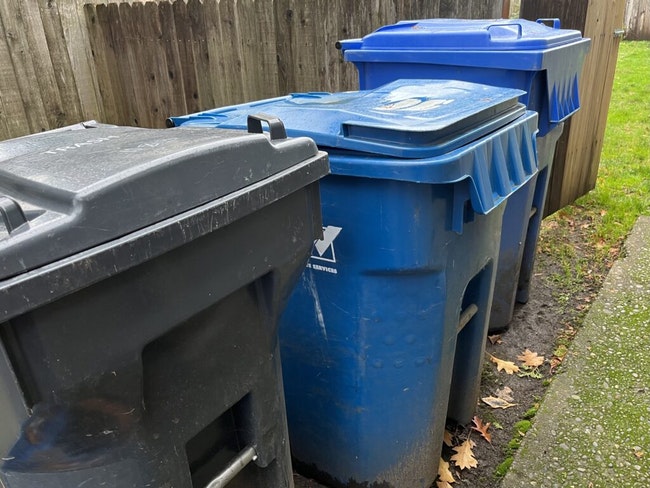
Trash and recycling bins sit outside a Salem yard. Oregon is working on modernizing its recycling system so residents can trust the items they’re recycling are actually recyclable. (Oregon Capital Chronicle/JULIA SHUMWAY)
Buy a bottle of dish soap, a jug of milk or a takeout container of Chinese food, and you’ll find an embossed triangular symbol of three arrows around a number.
The chasing arrows, a relic of recycling laws passed decades ago, would appear to indicate that an item could be dropped in a curbside recycling bin and be reincarnated instead of spending eternity in a landfill.
But there’s a catch – not all products with chasing arrows can actually be recycled, and recycling standards vary across the state and country. That leaves uncertainty for consumers wanting to be thoughtful.
Over the next several months, a task force appointed by Gov. Kate Brown will study misleading or confusing claims made by manufacturers about recycling and provide recommendations to the Legislature for new laws. The review is part of a larger effort to modernize recycling in the state as laid out in a law passed last year.
“The recycling system was built on policies that were created over 30 years ago, and not written to keep up with the changes in our consumer marketplace,” said Sanne Stienstra, project manager at the Oregon Department of Environmental Quality. “Our recycling system was built around recycling certain materials like newspapers, and not other things that we deal with and handle today, like packaging and shipping materials.”
The foam polystyrene used in egg cartons, to-go drink cups, packing peanuts and cushioning blocks for shipped appliances, for instance, can be recycled, so those products are marked with the chasing arrows symbol.
However, local governments and recycling providers don’t accept the foam in their curbside recycling programs, because recycling it takes more work than recycling other plastics. Tossing a block of foam into the recycling bin means someone down the line is going to have to fish it out, or could mean an entire load of recyclable materials is rejected and ends up in a landfill.
Manufacturers selling products in Oregon will be required to label them to indicate whether they can be recycled in Oregon, said state Sen. Michael Dembrow, the Portland Democrat who spearheaded the law. Dembrow said that will likely start as a sticker, but may shift to permanent marking as other states follow Oregon’s lead.
Dembrow has long been focused on reducing Oregon’s dependence on plastics. Then, beginning in 2018, China stopped importing the millions of tons of recyclable plastics generated in the U.S. and Europe. Addressing plastic waste became even more pressing.
“I can’t fault the Chinese for doing what they did,” Dembrow said. “They’ve been taking our garbage, frankly, for a long time. It’s not in good shape when it gets to them, and most of it, they have not been able to really sort and recycle, so it was going into their landfills or being burned.”
His measure, which passed both the House and Senate on mostly party-line votes, set up the task force and requires DEQ to establish statewide standards for recycling – so people in Pendleton can recycle the same materials as people in Portland. Brown has yet to appoint the 15-member task force, which is set to begin work in January.
The measure also requires companies that produce things like boxes, shipping envelopes, writing paper and food containers to join a producer responsibility association and follow rules that will be developed by the DEQ over the next few years.
DEQ can already assess fines of up to $25,000 per day for violating Oregon’s existing recycling laws, and that would extend to the new law. The department would use any proceeds from fines for a new grant program that would give local governments and nonprofit organizations money to develop more waste prevention programs.
Most Oregonians won’t see many changes until 2025, Stienstra said.
“If you live in rural Oregon, eastern Oregon, the southern part of the state, you’re more likely to see more changes because the services that are available are going to drastically improve and increase,” she said. “If you live in, say, the Portland metro area, the services that you see are already fairly robust, so you’ll see fewer changes.
The department will also work with companies to create additional options to recycle materials like foam packaging that couldn’t be dropped in a curbside bin or at a recycling depot, she said. Models for this already exist with items like computers or plastic grocery bags in states that haven’t banned them – you can’t stick a dead computer or a plastic bag in a recycling bin, but some stores and popup sites will recycle them.
During the few years before the new law takes full effect, Dembrow said Oregonians can help the state’s recycling by checking with their local government or garbage service to make sure that they’re only putting truly recyclable items in their blue bins.
“I think people should pay attention to that and try to follow those requirements to the best of their abilities,” he said. “And at the same time, they should be calling on us in the legislature to take steps to really have truth in advertising and make it easier for consumers to know what to do.”
Oregon Capital Chronicle is part of States Newsroom, a network of news bureaus supported by grants and a coalition of donors as a 501c(3) public charity.




